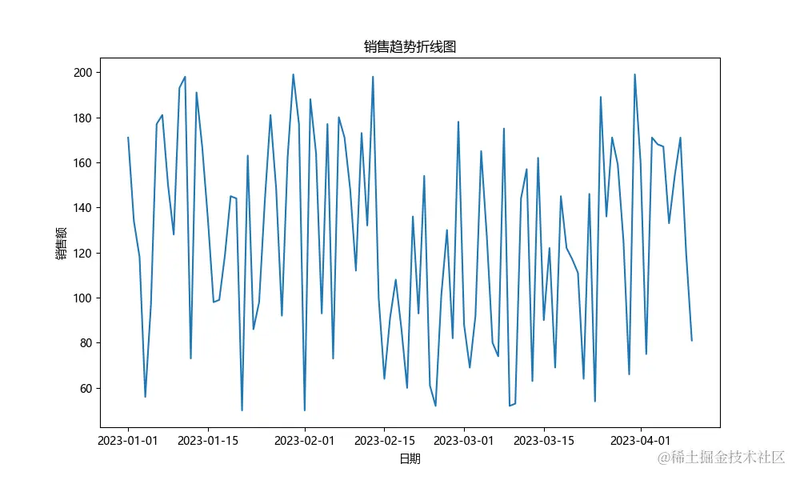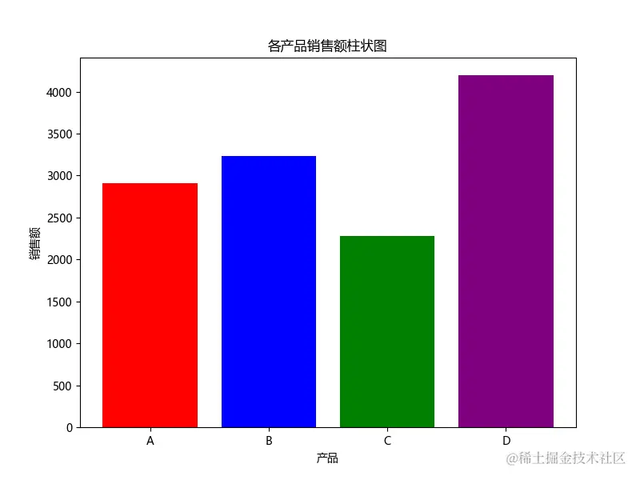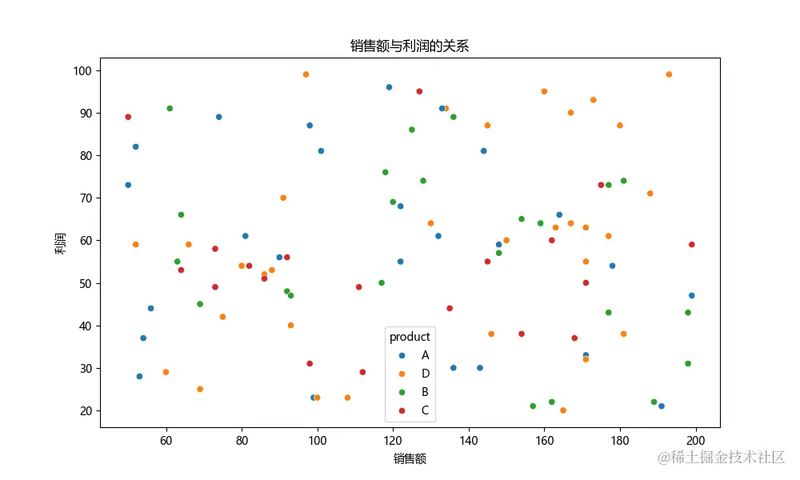数据可视化是数据分析中不可或缺的一部分,通过将数据以图形的方式展示出来,可以更直观地理解数据的分布和趋势。在 Python 中,Matplotlib 和 Seaborn 是两个非常流行和强大的数据可视化库。本文将详细介绍这两个库的使用方法,并附上一个综合详细的例子。
一、Matplotlib
Matplotlib 是 Python 中最基础也是最强大的数据可视化库之一。它提供了一整套绘图工具,可以创建各种类型的图表,如折线图、柱状图、散点图、饼图等。
1.1 Matplotlib 基础
基本使用
Matplotlib 的基本使用非常简单,只需要导入 matplotlib.pyplot 模块,然后使用其各种绘图函数即可。
import matplotlib.pyplot as plt
# 创建数据x = [1, 2, 3, 4, 5]y = [2, 3, 5, 7, 11]
# 绘制折线图plt.plot(x, y)plt.xlabel('X轴')plt.ylabel('Y轴')plt.title('简单折线图')plt.show()
复制代码
设置图形属性
我们可以通过设置各种属性来定制图形的外观。
# 设置线条属性plt.plot(x, y, color='green', marker='o', linestyle='dashed', linewidth=2, markersize=12)plt.xlabel('X轴')plt.ylabel('Y轴')plt.title('设置线条属性的折线图')plt.show()
复制代码
多图绘制
使用 subplot 函数可以在同一个窗口中绘制多个图形。
# 创建数据x = [1, 2, 3, 4, 5]y1 = [2, 3, 5, 7, 11]y2 = [1, 4, 9, 16, 25]
# 创建子图plt.subplot(2, 1, 1)plt.plot(x, y1, 'r--')plt.title('第一个子图')
plt.subplot(2, 1, 2)plt.plot(x, y2, 'g*-')plt.title('第二个子图')
plt.show()
复制代码
1.2 Matplotlib 高级
图例和标签
我们可以为图形添加图例和标签,以便更好地解释图表内容。
# 创建数据x = [1, 2, 3, 4, 5]y1 = [2, 3, 5, 7, 11]y2 = [1, 4, 9, 16, 25]
# 绘制折线图plt.plot(x, y1, label='质数')plt.plot(x, y2, label='平方数')
# 添加图例和标签plt.xlabel('X轴')plt.ylabel('Y轴')plt.title('添加图例和标签的折线图')plt.legend()plt.show()
复制代码
注释和文本
可以在图表中添加注释和文本,以便更详细地解释图表中的数据点。
# 创建数据x = [1, 2, 3, 4, 5]y = [2, 3, 5, 7, 11]
# 绘制折线图plt.plot(x, y)plt.xlabel('X轴')plt.ylabel('Y轴')plt.title('添加注释的折线图')
# 添加注释plt.annotate('最高点', xy=(5, 11), xytext=(4, 9), arrowprops=dict(facecolor='black', shrink=0.05))
plt.show()
复制代码
图表样式
Matplotlib 提供了许多内置的样式,可以轻松更改图表的整体外观。
# 使用内置样式plt.style.use('ggplot')
# 创建数据x = [1, 2, 3, 4, 5]y = [2, 3, 5, 7, 11]
# 绘制折线图plt.plot(x, y)plt.xlabel('X轴')plt.ylabel('Y轴')plt.title('使用ggplot样式的折线图')plt.show()
复制代码
二、Seaborn
Seaborn 是基于 Matplotlib 构建的高级数据可视化库,提供了更简洁的 API 和更美观的默认样式,特别适合用于统计数据的可视化。
2.1 Seaborn 基础
安装和导入
安装 Seaborn 非常简单,可以使用 pip 命令:
导入 Seaborn 也非常简单:
import seaborn as snsimport matplotlib.pyplot as plt
复制代码
基本使用
Seaborn 的基本使用方法与 Matplotlib 类似,但提供了更简洁的接口和更美观的默认样式。
# 导入数据集tips = sns.load_dataset('tips')
# 绘制散点图sns.scatterplot(x='total_bill', y='tip', data=tips)plt.xlabel('总账单')plt.ylabel('小费')plt.title('总账单与小费的关系')plt.show()
复制代码
绘制不同类型的图表
Seaborn 提供了许多用于绘制不同类型图表的函数,如箱线图、柱状图、热力图等。
# 箱线图sns.boxplot(x='day', y='total_bill', data=tips)plt.xlabel('星期几')plt.ylabel('总账单')plt.title('不同星期几的总账单分布')plt.show()
# 热力图flights = sns.load_dataset('flights')flights_pivot = flights.pivot('month', 'year', 'passengers')sns.heatmap(flights_pivot, annot=True, fmt='d', cmap='YlGnBu')plt.xlabel('年份')plt.ylabel('月份')plt.title('不同年份和月份的乘客数量')plt.show()
复制代码
2.2 Seaborn 高级
调整图表样式
Seaborn 提供了一些函数可以调整图表的样式。
# 设置图表样式sns.set_style('whitegrid')
# 绘制散点图sns.scatterplot(x='total_bill', y='tip', data=tips)plt.xlabel('总账单')plt.ylabel('小费')plt.title('总账单与小费的关系')plt.show()
复制代码
多图绘制
使用 FacetGrid 可以在同一个窗口中绘制多个图形,方便进行对比分析。
# 使用FacetGrid绘制多个图形g = sns.FacetGrid(tips, col='time')g.map(sns.scatterplot, 'total_bill', 'tip')plt.show()
复制代码
三、综合实例
下面是一个综合详细的例子,展示如何使用 Matplotlib 和 Seaborn 进行数据可视化。
3.1 示例数据集
我们将使用一个模拟的数据集,包含一些产品的销售数据。
import pandas as pdimport numpy as np
# 创建数据集np.random.seed(0)dates = pd.date_range('20230101', periods=100)df = pd.DataFrame({ 'date': dates, 'product': np.random.choice(['A', 'B', 'C', 'D'], size=100), 'sales': np.random.randint(50, 200, size=100), 'profit': np.random.randint(20, 100, size=100)})
复制代码
3.2 使用 Matplotlib 进行数据可视化
销售趋势折线图
我们首先使用 Matplotlib 绘制产品销售趋势的折线图。
import matplotlib.pyplot as plt
# 按日期汇总销售数据sales_trend = df.groupby('date')['sales'].sum()
# 绘制折线图plt.figure(figsize=(10, 6))plt.plot(sales_trend.index, sales_trend.values)plt.xlabel('日期')plt.ylabel('销售额')plt.title('销售趋势折线图')plt.show()
复制代码
各产品销售额柱状图
接下来,我们绘制各产品销售额的柱状图。
# 按产品汇总销售数据product_sales = df.groupby('product')['sales'].sum()
# 绘制柱状图plt.figure(figsize=(8, 6))plt.bar(product_sales.index, product_sales.values, color=['red', 'blue', 'green', 'purple'])plt.xlabel('产品')plt.ylabel('销售额')plt.title('各产品销售额柱状图')plt.show()
复制代码
3.3 使用 Seaborn 进行数据可视化
销售和利润的散点图
我们使用 Seaborn 绘制销售和利润的散点图。
import seaborn as sns
# 绘制散点图plt.figure(figsize=(10, 6))sns.scatterplot(x='sales', y='profit', hue='product', data=df)plt.xlabel('销售额')plt.ylabel('利润')plt.title('销售额与利润的关系')plt.show()
复制代码
产品销售分布箱线图
我们使用 Seaborn 绘制各产品销售分布的箱线图。
# 绘制箱线图plt.figure(figsize=(10, 6))sns.boxplot(x='product', y='sales', data=df)plt.xlabel('产品')plt.ylabel('销售额')plt.title('各产品销售分布箱线图')plt.show()
复制代码
3.4 综合实例的输出结果
通过运行上述代码,我们可以得到一系列图表,这些图表直观地展示了销售数据的分布和趋势。
销售趋势折线图:展示了整个时间段内的销售趋势,帮助我们识别出销售高峰和低谷。
各产品销售额柱状图:展示了不同产品的销售额对比,帮助我们确定哪些产品最受欢迎。
销售额与利润的散点图:展示了销售额和利润之间的关系,帮助我们分析销售和利润的相关性。
各产品销售分布箱线图:展示了不同产品的销售分布情况,帮助我们识别出销售额的集中区域和异常值。
通过这些图表,我们可以更好地理解和解释数据,从而做出更明智的决策。
四、总结
本文详细介绍了 Python 中两个主要的数据可视化库——Matplotlib 和 Seaborn 的使用方法,并通过一个综合实例展示了如何使用这两个库进行数据可视化。Matplotlib 提供了强大的绘图功能和高度的定制性,而 Seaborn 则提供了更简洁的接口和更美观的默认样式。根据不同的需求,我们可以选择合适的库进行数据可视化,从而更好地理解和解释数据。
作者:Rjdeng
链接:https://juejin.cn/post/7399985797540069386












评论